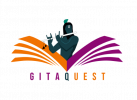Hello friends. We at Gita Quest are here to discover our best friend, true guide and the most valuable asset of our life -’The Bhagavad Gita’.
Festivals are the lifeline of Vedic Culture. We in India celebrate multiple types of festivals at every part of the country. Every region has its own customs and rituals. Jagganath Puri, in Orissa, organizes the world famous festival of Rath Yatra.
Today, we will discuss about this grand event. So, lets begin!

Rath Yatra is a festival associated with Lord Jagannath held at Puri in the state of Odisha, India. It is the oldest Ratha Yatra or Chariot Cart festival that take place in India and the world. The descriptions of Rath Yarta can be found in Brahma Purana, Padma Purana, and Skanda Purana and Kapila Samhita.
This annual festival is celebrated on Ashadha Shukla Paksha Dwitiya (second day in bright fortnight of Ashadha month).
The presiding deities of the Jagannath Temple, Puri's main temple, Lord Jagannath, Lord Balabhadra and Goddess Subhadra, with the celestial wheel- Sudarshana Chakra are taken out from the temple in a ceremonial procession to their chariots. The huge, colourfully decorated chariots are drawn by multitude of devotees on the bada danda, the grand avenue to the Gundicha Temple (Gundicha– King Indradyumna's Queen), two miles away to the North.
It is the popular belief that those who are not allowed to enter the temple premises, Lord Jagannath himself comes out of the temple every year to give them Darshan. He, as a king of Puri, visits his kingdom annually to meet his subjects personally.
On their way back from the Gundicha Temple, the three deities stop for a while near the Mausi Maa Temple (Aunt's abode) and have an offering of the Poda Pitha, which is a special type of pancake supposed to be the Lord's favourite. After a stay for seven days, the deities return to their abode.
Chariot:- The three chariots of Lord Jagannath, Balabhadra and Subhdra are newly constructed every year with wood of specified trees like phassi, dhausa, etc. They are customarily brought from the ex-princely state of Daspalla by a specialist team of carpenters who have hereditary rights and privileges for the same.The three chariots are decorated as per the unique scheme prescribed and followed for centuries.
Unique Chariots
Lord Jagannath
Name of Chariot-Nandighosa,
Number of wheels -16,
Colours of the canopies - Red, Yellow.
(yellow associated with Vishnu).
Balbhadra
Name of Chariots- Taladhwaja,
Number of wheels- 14,
Colors of the canopies- Red, Bluish and Green.
Subhadra devi
Name of Chariot - Darpadalana,
Number of Wheels - 12,
Color of the canopies - Red, Black.
(Black associated with the Goddess).
Chera Pahara ritual
The most significant ritual associated with the Rath-jatra is the chera pahara. During the festival, the Gajapati King wears the outfit of a sweeper and sweeps all around the deities and chariots in the Chera Pahara (sweeping with water) ritual. The Gajapati King cleanses the road before the chariots with a gold-handled broom and sprinkles sandalwood water and powder with utmost devotion. As per the custom, although the Gajapati King has been considered the most exalted person in the Kalingan kingdom, he still renders the menial service to Lord Jagannath. This ritual signified that under the lordship of Jagannath, there is no distinction between the powerful sovereign Gajapati King and the most humble devotee.
Chera pahara is held on two days, on the first day of the Ratha Jatra, when the deities are taken to the garden house at Mausi Maa Temple and again on the last day of the festival, when the deities are ceremoniously brought back to the Shri Mandir.
So friends, we hope you liked the blog on rathyatra festival. To get more such blogs stay tuned with us and do register to the free Gita course provided by the expert team of IITians. Press the link given below! Hare Krishna!


